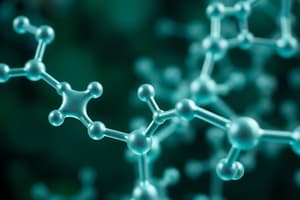Podcast
Questions and Answers
What are the building blocks of proteins?
What are the building blocks of proteins?
- Carbohydrates
- Nucleic acids
- Lipids
- Amino acids (correct)
What is the primary function of carbohydrates in the human body?
What is the primary function of carbohydrates in the human body?
- Providing structure to cells
- Regulating hormone production
- Sparing proteins
- Storing energy (correct)
What is the role of lipids in the human body?
What is the role of lipids in the human body?
- Regulating body temperature
- Providing energy and structural components (correct)
- Storing genetic information
- Synthesizing proteins
What is the function of RNA in the human body?
What is the function of RNA in the human body?
What is the primary function of proteins in the human body?
What is the primary function of proteins in the human body?
What is the function of DNA in the human body?
What is the function of DNA in the human body?
What is the primary source of food energy for humans?
What is the primary source of food energy for humans?
Which of the following is naturally found in milk?
Which of the following is naturally found in milk?
What is the most abundant monosaccharide?
What is the most abundant monosaccharide?
What is the function of glycogen?
What is the function of glycogen?
What are the building blocks of triglycerides?
What are the building blocks of triglycerides?
What is unique about phospholipids?
What is unique about phospholipids?
What is the significance of the Kelvin scale in Charles' Law?
What is the significance of the Kelvin scale in Charles' Law?
What is the relationship between the volume of a gas and its temperature according to Charles' Law?
What is the relationship between the volume of a gas and its temperature according to Charles' Law?
Why does a gas expand when heated?
Why does a gas expand when heated?
What is the correct formula to convert Celsius to Kelvin?
What is the correct formula to convert Celsius to Kelvin?
What is the main component of carbohydrates?
What is the main component of carbohydrates?
What is the mnemonic used to classify biomolecules?
What is the mnemonic used to classify biomolecules?
Flashcards are hidden until you start studying
Study Notes
Amino Acids
- 20 amino acids are the building blocks of proteins, composed of carbon, hydrogen, nitrogen, oxygen, and sulfur.
- Divided into two categories: Essential Amino Acids (gained from diet) and Non-Essential Amino Acids (synthesized from the body).
Nucleic Acids
- DNA (Deoxyribonucleic Acid) is a double-helix molecule composed of deoxyribose, phosphate backbone, and nitrogenous bases (adenine, guanine, thymine, and cytosine).
- DNA contains genetic instructions.
- RNA (Ribonucleic Acid) is a single-helix molecule composed of ribose sugar, phosphate backbone, and nitrogenous bases (adenine, uracil, guanine, and cytosine).
Importance of Biomolecules
- Carbohydrates are the major source of energy for humans, used for energy production, energy storage, building macromolecules, sparing proteins, and assisting in lipid metabolism.
- Lipids are another source of energy, used as structural components of cells, energy storage, and signaling molecules.
- Proteins help build tissues, repair damage, function as hormones and enzymes, provide fluid, and are involved in wound-healing and energy production (ATP).
- Nucleic acids are essential for DNA, the blueprint for life, and RNA, necessary for creating proteins.
Chemical Reactions
- A chemical equation is a shorthand notation for a chemical reaction, showing reactants, products, and phases.
- The equation consists of reactants (left) and products (right).
Carbohydrates
- Monosaccharides are single-unit sugars, such as glucose (dextrose), fructose (fruit sugar), and galactose.
- Disaccharides are two-unit sugars, such as sucrose (found in fruits and vegetables), lactose (found in milk), and maltose (used for germinating seeds).
- Polysaccharides are many-unit sugars, with examples including starch (primary source of food energy), glycogen (provides quick energy boost), and cellulose (stabilizes cell walls).
Lipids
- Lipids are water-insoluble and composed of CHO, with building blocks of glycerol.
- Examples include triglycerides (fats and oils, such as olive oil and butter), phospholipids (similar to triglycerides but with a phosphate group), and cholesterol (containing various hydrocarbon ring structures).
Proteins
- Proteins are polypeptides containing long chains of amino acids connected by a peptide bond.
- Consist of three parts: alpha carbon, amino group, carboxyl group, and R-group.
- Amino acids are classified based on their polarity and electrical charge.
Charles' Law
- Made by French physicist Jacques Charles (1746-1823).
- States that the volume of a given mass is directly proportional to the temperature of the gas, given constant pressure.
- Linking to Kinetic Molecular Theory, an increased energy inhibits rapid moving molecules, explaining heat and requiring gas to expand.
- The Kelvin scale is used, with 0K representing complete stoppage of molecules.
Studying That Suits You
Use AI to generate personalized quizzes and flashcards to suit your learning preferences.




